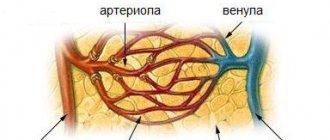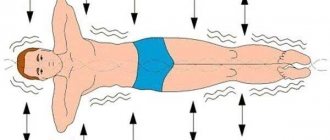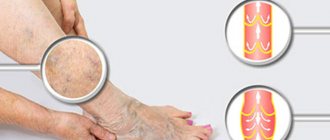Pyotr Dmitrievich Puzdryak
cardiovascular surgeon, 1st category doctor
Publication date: 03/26/2021
If you have been diagnosed with varicose veins in the legs, your doctor will probably advise you to move more: get up more often to stretch, walk and perform special therapeutic exercises. However, not all exercises are suitable for varicose veins. We tell you what to do to improve the condition of your veins, and what activities it is recommended to avoid.
Effective exercises in the treatment of varicose veins
Getting rid of existing varicose veins is not so easy. Treatment may include both taking venotonics and surgery. Physical therapy may also help you. Ask your doctor which exercise routine is best for you. In addition to special methods that are used under the supervision of a specialist, there are exercises that you can perform independently.
We list effective and simple exercises that are suitable for both the prevention and treatment of varicose veins.
Walking _ Walking for at least 30 minutes a day promotes good health. Muscle contraction pushes blood upward.
Swimming . If you are a beginner, you can start with a combination of 30 seconds of activity and 30 seconds of rest, gradually increasing the time. Water aerobics is also useful.
A ride on the bicycle . Cycling trains the calf muscles. Watch your posture and how long you ride your bike. The loads should not be too heavy.
Exercise "bicycle" . This simple exercise should be performed while lying on your back. Raise your legs up, imagine that you are riding a bicycle and turning the “pedals”.
Raising legs at right angles . Lie down on the floor or bed. Raise your legs up and lean them against the wall. Stay in this position for a couple of minutes. The exercise can be done several times a day.
Alternating leg raises . Lie on your back with your legs extended. Slowly lift your right and left legs alternately, holding them in the air for a few seconds.
Ankle rotation . Rotate your feet at the ankles in one direction or the other.
Calf raise . This exercise is performed standing straight, feet shoulder-width apart. Slowly rise up onto your tiptoes, pause, and then lower down. Repeat several times.
Exercises against varicose veins of the legs: prevention stage
You don't have varicose veins and want to avoid developing them in the future.
Proper physical activity is a good way of prevention, so we recommend starting with daily walks: walking or cycling. Swimming is very helpful in preventing varicose veins; we just note that all of the listed types of physical activity should be present in your life regularly. Experts also recommend performing a set of exercises, mainly for the legs, which will help avoid problems with veins. Their main task is to “include” the leg muscles in the work, but not to put unnecessary stress on them.
- Sitting on a chair, stretch your legs and perform circular movements with your feet in turn (15 times with each leg).
- Sitting on a chair, place one foot on your toes and the other on your heel. Change position. Repeat 10-15 times.
- From the same starting position, place your feet on your toes, pulling your heels as high as possible. Smoothly lower your feet. 10-15 repetitions. The same exercise can be done for each leg separately.
- Standing on the floor, rise onto your toes (can be done with support) and lower onto your heels. 15 reps. The same exercise can be performed with your feet shoulder-width apart and, lowering yourself, squatting.
- Stand on the floor, feet shoulder-width apart. As you inhale, alternately rise on your toes or on your heels (the toes rise as high as possible). As you exhale, return to the starting position. 15 reps.
- The exercise is performed from a starting position standing with support on a chair. As you inhale, the leg moves smoothly to the side, and as you exhale, it lowers. 15 repetitions on each leg.
- From the starting position lying on your back, perform the bicycle or scissors exercise. This exercise can be made more difficult if you perform it from a sitting position (on the edge of a chair).
- Lying on your back, raise your legs straight up. From this position, pull your socks towards you, then return your feet to their original position. Do 10-15 times.
- Lying on your back, stretch your legs up, toes pointing to the ceiling. From this position, spread your straight legs and bring them together. 10-15 repetitions.
- Starting position - sitting on the floor with support on your hands. Legs are bent at the knees. Hold a small ball between your legs, tense your legs, then relax. 10 reps.
You can create for yourself the optimal set of these and other exercises for varicose veins on the legs. It is not necessary to do them all, but you can and should devote 10-15 minutes a day to your health. If you regularly play sports in the gym, then change strength training to water aerobics or Pilates - these are excellent types of exercise therapy for the prevention of varicose veins of the lower extremities.
Complete the complex with a contrast shower or foot bath.
What exercises should you not do if you have varicose veins in your legs?
Moderate physical activity is useful for the prevention and treatment of varicose veins of the lower extremities. However, some exercises can have the opposite effect.
- Sports activities involving heavy lifting, such as weightlifting, are contraindicated.
- An exercise such as deep active squats is not recommended.
- Avoid high-intensity running and long runs.
- Do not engage in sports that involve vigorous jumping.
- If an exercise causes you pain or discomfort, stop doing it.
Before you start doing leg exercises, be sure to consult a specialist. Don't forget that exercise is part of a comprehensive vein care program. Follow all your doctor's recommendations.
Exercises for varicose veins, performed in a lying position
If possible, it is recommended to lie down 3-4 times a day for 10-15 minutes, giving your legs an elevated position, then perform the following exercises.
Starting position: lying on your back on the couch,
Exercise 1.
Spread your arms to the sides (inhale), lower them along the body (exhale). Repeat 3-4 times.
Exercise 2.
Simultaneously bend and straighten your feet and fingers. Repeat 10-12 times.
Exercise 3.
Tighten and relax the thigh muscles (at the same time, the kneecaps move). Breathing is voluntary. Repeat 10-12 times.
Exercise 4.
Bend and straighten your toes. The pace is slow. Breathing is voluntary. Repeat 10-15 times.
Exercise 5.
Diaphragmatic breathing: as you inhale, the anterior abdominal wall rises, as you exhale, the abdomen retracts. 3-4 inhalations and exhalations. The pace is slow.
Exercise 6.
Alternately bend and straighten your legs at the knee joints. Repeat 3-6 times with each leg.
Exercise 7.
Pull your leg to your chest, straighten it vertically upward, hold it and slowly lower it. Repeat 3-6 times with each leg.
Exercise 8.
The legs are bent at the knee joints. Diaphragmatic breathing. 4-6 inhalations and exhalations.
Exercise 9.
Legs are extended and spread. Turn your feet and knees in and out. Repeat 8-10 times.
Exercise 10
Hands to shoulders. Make circular movements in the shoulder joints - forward, then back. Repeat 4-5 times on each side.
Exercise 11.
Legs are bent at the knees. Tilt your legs left and right. Repeat 6-8 times.
Exercise 12.
Legs are straightened. At the same time, take the same leg and arm to the side. Repeat 3-4 times on each side.
Exercise 13.
Alternately bend and straighten your feet with force (as if pressing the pedals). Repeat 6-12 times.
Exercise 14.
Legs are spread. Bend one leg and use the opposite hand to reach the heel. Repeat 6-12 times with each leg.
Exercise 15.
“Bicycle”: 2-3 series of 6-8 movements (hands can be placed behind the head).
Exercise 16.
Diaphragmatic breathing: while inhaling, the stomach first “inflates”, then the chest expands; As you exhale, the stomach retracts and the chest “collapses.”
Exercise 17.
Legs are bent, arms are extended along the body. Raise one leg vertically up, hold it in this position, move your toes and actively rotate your foot. Repeat 2-3 times with each leg (until fatigue appears in your legs).
Exercise 18.
Hands are clasped, legs are spread. Raise your arms up (above your head), stretch and spread your arms to the sides (inhale). Lower your hands (exhale). Repeat 4-5 times.
Starting position: lying on the left side (then the entire series is repeated in the starting position lying on the right side)
Exercise 19.
The left hand is under the cheek, the right hand is on the thigh, the legs are bent. Move your right arm and leg to the side (vertically upward). Repeat 4-5 times.
Exercise 20.
Bend your right leg and pull your hand towards your stomach. Repeat 6-8 times.
Exercise 21.
Move your right arm to the side while turning your torso. Repeat 4-5 times.
A set of exercises for people over 50 years old
Exercise therapy for people over 50 will be aimed, among other things, at general strengthening of the body.
- In a supine position, we move one-sided limbs to the side. We return to the starting position. We repeat on the other side.
- We lie on our stomachs, resting our palms on the floor at the level of the shoulder joints. Slowly straighten your arms and bend your spine.
- We stand up, stretch our arms up and join our palms. Alternately place one or the other foot with the sole on the inner surface of the opposite thigh. We try to bring the foot as close to the perineum as possible.
- We walk in place for a few minutes.
Additional ways to treat the disease
To normalize the functioning of venous vessels, not only exercise therapy is used, but also wearing compression garments, venotonics, diet, massage and some sports.
Sport
Professional sports activities with varicose veins in the legs and other types of disease are not encouraged. Sports involve intense physical activity, which can damage blood vessels. The following amateur sports activities are possible:
- Water aerobics (except step elements);
- Swimming;
- Cycling (when riding a bicycle, raising the seat higher will be very effective);
- Dancing (not associated with frequent jumping);
- Golf;
- Race walking.
Massage
It is better to entrust massage for varicose veins to a specialist. If this is not possible, then during self-massage you need to perform soft stroking, massaging movements with your hands, kneading your feet, legs, thighs, and buttocks. You need to move from bottom to top.
Attention!
Do not try to actively knead dense veins protruding above the surface of the skin, this can only worsen the situation and provoke inflammation.
Diet
Dietary recommendations for vein problems include eating foods such as:
- Seafood – helps strengthen the vascular wall and increase its elasticity;
- Foods rich in vitamin C - bell peppers, Brussels sprouts, cauliflower, broccoli, black currants, rose hips, dill and parsley, citrus fruits;
- Fresh fruits and vegetables that stimulate digestion and prevent constipation.
The described training will be useful not only to people at risk for varicose veins, but also to every person who leads a sedentary lifestyle, is overweight and wears uncomfortable shoes. Such gymnastics will be useful for the veins and relieve fatigue from the legs.
Contraindications to exercise therapy
It is important to remember that physical therapy for venous pathology has a number of contraindications:
- The last stages of varicose veins, when only surgical treatment can help;
- Inflammatory changes in the veins: phlebitis, thrombophlebitis;
- Malignant neoplasms;
- Complicated pregnancy;
- Severe diseases of the cardiovascular system;
- Acute infectious processes.
Most of these restrictions are relative or temporary, but there are sports that you should definitely not do if you have varicose veins:
- Weightlifting, weight lifting;
- Jumping and running;
- Step aerobics;
- Squats;
- Strong stretch.
Important!
If you have doubts whether you can engage in a certain sport, what exercises you should do and what you shouldn’t, then it is better to consult a phlebologist or exercise therapy doctor: each clinical situation has its own characteristics, and only a doctor can tell you how strict the prohibitions are in your case .
Preventive complex
If varicose veins have not yet begun, but such a risk exists, it is recommended to perform the following exercises:
- Lie down on a horizontal surface. Stretch your legs towards the ceiling, spread them to the sides, perform rotational movements with the outstretched toes of your feet.
- Similar to the first task, we rotate not with our feet, but with our shins, first clockwise and then counterclockwise.
- From a lying position, raise your legs by placing them on a stool. Bend your feet towards and away from you.
- After performing a stand on the shoulder blades, we spread and bring together the straightened legs.
- Jump on your tiptoes a little.
Exercise therapy at the initial stage of pathology
We present a variant of therapeutic exercises for the correction of initial varicose veins of any location: legs, arms, pelvic organs.
- Stretching out on a horizontal surface, first bend one leg towards you, then stretch it up, perpendicular to the floor. After holding it straight for a few seconds, return it to the floor. Repeat the exercise with the other leg, and then with both legs at once.
- Now you need to sit on a stool resting on your heels. Move your toes left and right.
- We get up and perform the classic gymnastic element “swallow”, standing on one leg, moving the straightened arms “wings” to the sides and extending the second leg “tail” back.
- For about a quarter of an hour we consistently walk on our toes, on our heels, raising our hips high.








